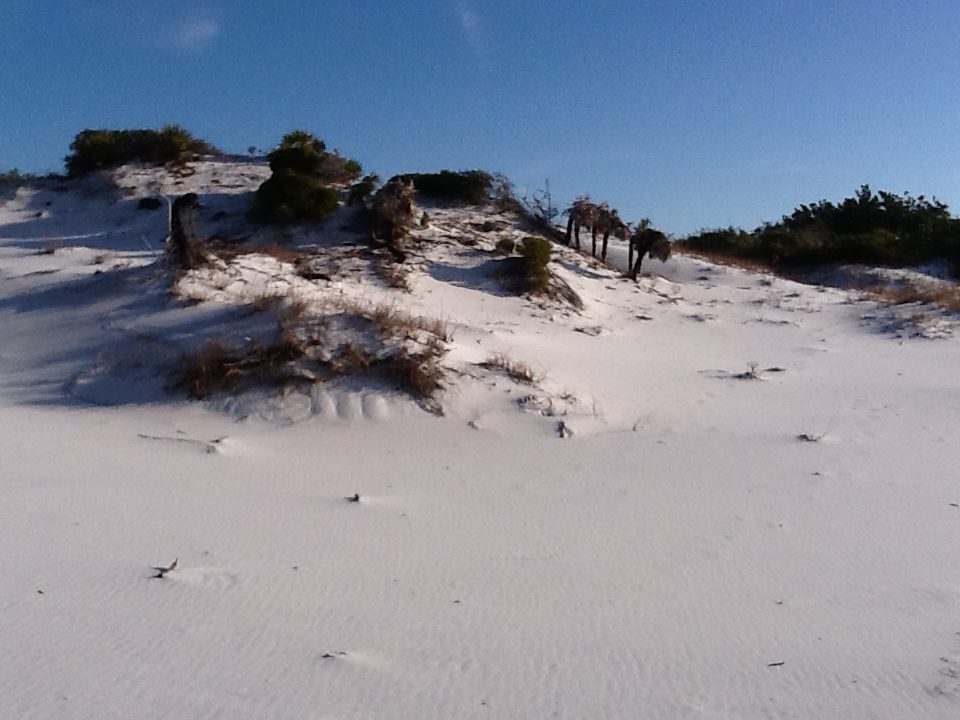There are a lot of cool and interesting creatures that live on the barrier islands of Northwest Florida. The conditions out there require they make changes and adaptations different from what they would do in a more upland or wetland environment. Some creatures are unique to these beach and dune systems and found nowhere else. But to begin this series lets first look at the islands themselves.

Photo: Rick O’Connor
The name barrier island comes from the fact that they do serve as a barrier between the open Gulf of Mexico and the mainland of the Florida panhandle, protecting coastal communities from storm surge and waves of the all too frequent hurricanes and tropical storms. They are basically sandbars formed with sands from the Appalachian Mountains. There the wind, rain, and temperature erode the granite rock into its mineral components and wash them downstream. First in the fast-moving mountain streams, then into creeks, into rivers which eventually discharge into the Gulf. The different minerals settle out based on their size, type, and densities. Quartz is one of the less dense and is the dominant mineral forming the coastal barrier islands, making them some of the whitest beaches on the planet.
When these quartz sands reach the Gulf, they encounter longshore currents that are formed from the winds blowing across the open water. In this part of the Gulf of Mexico these currents tend to move from the east to the west in most cases. As the rivers reach the passes that connect the estuaries to the open Gulf and the longshore currents move the sand into long thin spits at the mouth of the bays running parallel to the coastline. In some cases, the sand bars form perpendicular to the coastline, and we call them capes. Initially still connecting to land, many creatures can venture out on these sand spits searching for food. Some of the sand spits are very small and seem to come and go as the winds and waves move them. At times these smaller spits may actually close off the opening into the bay as they once did on Perdido Bay and still do with the Walton County dune lakes. In other cases, the spits accumulate more sand, become long and can eventually break contact with the mainland forming an island.

At first these islands can be nothing more than sand bars. Barely above sea level, moving and changing very quickly, sometimes disappearing and reappearing in slightly different locations after storms, such as Sand Island off Dauphin Island Alabama. In others they are larger, harder to move quickly and may be vegetated so that movement is slower and the island more established, such as Santa Rosa Island near Pensacola. The creatures on any of these islands will need to be able to adapt to the new conditions. Some will be able to leave and return the mainland when they need or want to. Birds are very common on all forms of barrier islands due to the fact they can fly. In some cases, the distance from the mainland is not a far swim for those who can, such at Indian Pass near St. Vincent Island. In some cases, the distance may not be as close and the currents between very swift during tide changes making crossing more difficult. In these cases, the creatures who find themselves on these islands must adapt to the new conditions or risk losing their populations entirely.
Island conditions can be tough. There is a lot of wind, and this wind carries salt spray. There is little cover from the intense sun during the summer months. Needed freshwater can be hard to find. Some islands will develop freshwater systems, but others will not. And then there is the fact that it is an island. Thus, a finite amount of resources and space for each species, and, at times, fierce competition for those.
In Part 2 we will explore the different habitats that developed on these islands that available for the different wildlife that exploit them.

 2
2
